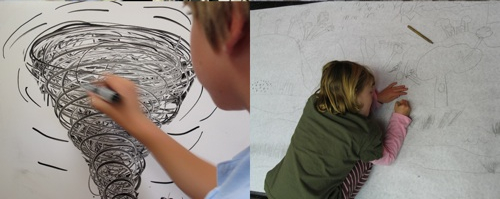
New Kentridge Resources for Educators
With the release of our new film, William Kentridge: Anything is Possible, those of us involved in developing the educational resources presented in tandem with our films suddenly had a new kind of resource with which to work. This hour-long study of Kentridge’s work provided an opportunity to delve deeper into the motivations, intentions, considerations, and machinations of an artist working in many media, with many collaborators, and on a wide range of visual and performance-based projects. We spent some time thinking about the most suggestive and useful ways to inspire teachers to use the film.
In addition to producing the Educators’ Guide and Screening Companion that looks at the 10 individual chapters of the film as unique opportunities for dialogue and exploration, we wanted to utilize the amazing collection of related media being presented on the companion website. We wanted to capitalize on the unique opportunity to connect video, images, and quotes with compelling questions and projects that would help teachers explore some of the themes that are central to Kentridge’s work with students.

On Theme
Four thematic mash-ups—On Theme—will be released over the next four weeks. The first theme is “Play”—an activity so central to childhood and yet often difficult to maintain as adults. For Kentridge, play is central to his identity as an artist and deeply embedded in his working process.
Case Studies
In addition to providing our own suggestions, we wanted to find out how teachers were using Kentridge in the classroom and what the William Kentridge: Anything is Possible film would inspire. We asked teachers across the country to share with us their own narratives about teaching with Kentridge. The result is a series of Case Studies written by educators for educators that tell stories about how teachers are bringing Kentridge’s art into interdisciplinary curricula. These educators are experimenting with different ways of teaching using themes and ideas at the center of the artist’s work as well as our film.
Each week we will present several examples of curriculum units, lesson ideas, or classroom narratives inspired by Kentridge’s Five Themes retrospective exhibition and the William Kentridge: Anything is Possible film. This week the first three case studies present teachers in San Francisco, CA, and Hastings-On-Hudson, NY. Jennifer Stuart, Garth Applegate, and Nate Morgan share the first installments from a series of reflections they will be presenting as they embark on two separate semester-long performance and video based projects inspired by the film. In addition, Trena Noval shares some of the video projects she has created with elementary students after seeing Kentridge’s work at SFMoMA in 2009.

The William Kentridge: Anything Is Possible BACK TO SCHOOL campaign recognizes the important work being done by art educators across the country and our own education team at Art21. This campaign is designed to not only raise awareness of the free education programs and resources affiliated with the film, but to acknowledge Art21’s commitment, as a non-profit, to support the efforts of educators bringing contemporary art into their classrooms in dynamic and meaningful ways. By giving today, your contribution directly supports the production of these resources and the work of educators across the country.
Look for additional Case Studies and On Theme materials on the William Kentridge: Anything Is Possible site over the course of the next four weeks as well as opportunities to contribute to the campaign.



